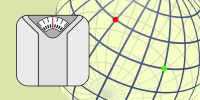Gravity Variations
 |
Is it true that, depending on where you live in the World, you might weigh a different amount? Yes, if you desire, you can travel to a different location on the planet where you might weigh more or less than you currently do* How and why does this happen? How much difference can you make? |
*Unless you are already at the min or max point, then you can only go the other way!
Mass and Weight
|
The first thing to mention is that your mass is not changing; it is your weight that is. What is the difference? Well, mass is the amount of ‘stuff’ in your body (The technical term for this ‘stuff’ is ‘matter’). Weight is the force acting on your mass because of gravity. Mass is correctly measured in Kg (if you use the Metric system, which you should. Don’t hate, just embrace it). Weight is measured in Newtons (which is a measure of force). Confusingly, in common vernacular, the terms weight and mass are (incorrectly) used interchangeably. This pisses off physicists no end! My High School Physics teacher even used to hand out detentions to any student who incorrectly used the wrong term. |
 |
 |
Mass is also something called a scalar quantity. It has a magnitude, but no direction. Weight is a vector, it has both magnitude and direction. |
|
When someone is “weightless”, then are not “massless”; they are just not experiencing any unbalanced forces. Oh and (just in case my Physics teacher is reading this) astronauts having the time of their lives floating around in orbit are still exposed to gravity; there is still gravity in orbit. In fact, in low Earth orbit of a couple of hundred Km, the value of gravity is still approximately 90% of what is experienced on the surface of the planet. Astronauts feel weightless because they are constantly ‘falling’ around our planet (as is everything else around them), not because there is no gravity. |
 |

Free falling
 |
You can experience weightlessness on Earth without needing to go into orbit; Just stand on a chair, and jump off! As you are accelerating towards the floor you will temporarily experience weightlessness. Want to experience a longer period of weightlessness? Jump off a table. A longer period? Find a tall diving board at a local swimming pool. Need more? Go sky diving! |
|
Interestingly, a couple of hundred years ago, this understanding of free-falling was exploited to make spherical shot (bullets) for guns much cheaper, faster, and more accurately than using molds. Tall chimney towers were constructed (called ‘Shot towers’) to manufacture lead shot. Molten lead was transported to the top of these towers and allowed to drip through copper sieves before free-falling down a tall vertical shaft. On the way down, surface tension would pull the lead spherical in shape, and give sufficient time for it to cool and solidify in this spherical shape before landing in a water bath at the bottom of the tower to consolidate this cooling. The process was patented by William Watts in the UK in 1782, who built the first shot tower in his back yard as an extension to his house! Though no longer used for the construction of shot, the concept is still in use today for scientific research. “Drop tubes” allow scientists to expose experiments to a couple of seconds of zero gravity by dropping their experiments down shafts. These drop tubes don’t just need to be towers! One of NASA’s facilities is a deep hole in the ground that allows things to fall 155 m (510 ft) down. (There is still air inside drop tubes, which provides a small resistive force; one of the biggest operating pains of these scientific towers is the process of evacuating the tubes of air to an acceptable level of vacuum, if needed, for a particular test). The image on the right is the Clifton Shot Tower in Melbourne, Australia. It was constructed in 1882 and is 80m tall (263 ft). Yes, shot towers look like tall chimneys! |
 Image: Matnkat Image: Matnkat |

Back to Gravity
So, what is gravity? The short answer is that we don't know. The longer answer is that we don't know.
|
[SHORT ANSWER] What we do know is that matter is attracted to other matter, and this attractive force is what we call gravity. From Newton, we learned that the more massive something is, the stronger the attractive force, and the closer another mass is, the stronger the force (in an inverse square way). [LONGER ANSWER] Einstein, in his relativity theory, explained that gravity is not just a force but a curvature in the space-time continuum. You can't 'see' this curvature, but it effects objects as they pass by. It's easy to think of gravity as strong, but actually it's incredibly weak; by far the weakest of the four known fundamental forces (gravitational force, electromagnetic force, weak force, and strong force), but it does make up for this by being very long ranged. Oh, and when things get down to a very small scale, gravity packs its bags and stops behaving. We really still have so much more to learn … We don't know what causes gravity. Sometimes you might hear people talk about 'gravity waves', or 'graviton' particles, but this is just speculation, and at the current time we simply don't understand enough. Going back to the concept of drop tower, Galileo might have used The Leaning Tower of Pisa as a rudimentary drop tower to show that objects accelerate at constant rate, irrespective of their mass. |
 |
 |
(I almost didn't want to mention special relativity because yes, at high relative velocities, mass changes, but since we're comparing two locations on the planet in the same frame of reference, we don't need to factor this in. We are moving along with the planet and so can work with the concept of rest mass. If you are whizzing past the planet at a good percentage of the speed of light, please ignore the rest of this article). |
Constant mass; changing weight
Because your mass is not changing, if your weight is changing as you move to different places on the earth, then this has to be because of variations in gravity.
Gravity is a measure of the acceleration the Earth imparts on us. In Metric (SI), acceleration is typically measured in metres per second per second (metres per second squared). You can also think of it as Newtons per kg; how much force is needed to accelerate mass. As we will see later, it varies around the planet, but an average value is approximately 9.81 m/s2.
It's good to have a standard, and even though it varies, there is a defined standard value for gravity, and this denotated by gn
gn = 9.80665 ms-2
Every Kg of mass experiences approx 9.81 Newtons of force because of the attraction of gravity.
Variations
In approximate order of importance, here is a list of the reasons why gravity varies around our planet:
Oblateness and distance from the centroid
As mentioned in a previous article, our planet is not a perfect sphere. If the Earth were perfectly spherical, of uniform density, (and not spinning), then the gravitational force would be the same over the entire surface.
However, millennia of spinning around has caused it to bulge around the middle. The diameter around the equator is larger than the diameter around the poles. This delta might be small, but it is very measurable.

|
It's also not quite as simple as that either. The earth is not just a basic oblate spheroid. There are other harmonic bumps and bulges (even before we start to think about mountains and ridges and trenches carved into and on the surface!) If you stand on the equator (or on the top of a mountain), you are further away from the centroid of the Earth. Gravity falls off with the inverse square of the distance between the centers of masses of the two objects in question. The further you are from the center of the earth, the lower the force of gravity. (Remember, in low earth orbit, at a couple of hundred kilometres altitude, we mentioned that gravity is approx 90% of that at sea level. This is for the same reason.) |
 |
|
How much difference does this make? Well, the formula for the reduction of gravity based on altitude (above the earth*) is easy to derive. Using a reference value for gravity, and a reference radius, and height above this radius, we get: With altitude, the reduction in gravity can be as much as 0.3% at the top of really tall mountain. |
 |
* Below the surface of the earth it's a little more complicated to caclulate because, yes, the majority of the earth (that still under your feet), still appears to be acting from the centroid, but there is now some 'above' you pulling you back the other way. There is a way to calculate this as a series of infinitely thin spherical shells and calculus. Oh, and the earth is not made of uniform density material (the core an mantle being much more dense than the crust).
So, yes, being in an airplane you weigh slightly less than at ground level (even more so if you are flying over the sea than the land, as we will see later). Does that mean that people standing at the poles weigh less than people on the equator, well, yes and no, it's not just quite as simple as that because the earth is spinning …
Rotation
|
If you've even ridden on a roundabout at a children's playground you know that, as it spins, you have to hold yourself on. The faster it spins, the more you have to hold on. This force you have to hold on with is called a centripetal force (the equal and opposite reaction force you feel pushing you out is called the centrifugal force). If you don't hold on you'll fly off from the roundabout at a tangent (not outwards). In accordance with Newton's First Law, if you let go, as you are no longer being acted upon by an exterior force, you will carry on in a straight line at constant speed. |
 Image: David Maddison
Image: David Maddison |
 |
The earth is spinning and, depending on your latitude, you spin at a certain radius. When you are at the equator you are spinning in a large radius circle. Near to the poles, very small. The force required to pull you around in these circular arcs reduces, slightly, the gravitational force. This reduction is greatest at the equator, where the radius is the largest, is zero at the poles, and varies in between these extremes based on latitude. At the equator, the reduction results in a approx 0.3% decrease in weight. The rotational reduction of gravity at the equator compounds the reduction because of the oblatness, giving a double boost to the reduction experienced there. |
Altitude
Moving higher up a mountain reduces gravity because you are further away from the center of the earth, but it's not all roses. As you move higher, the air in the atmosphere gets thinner. Because it is thinner, there is less buoyancy effect. The makes you weigh a little more.
The effective reduction from buoyancy losses, however, are second order compared to the radius increase of getting higher. For the 0.3% decrease obtained by climbing very tall mountain, the increase because of buoyancy is just 0.08%
Geology and topology
 |
The Earth is not homogeneous. Local variations in topography (such as the presence of mountains) and geology (such as the density of the different kinds of rocks) cause small fluctuations in the Earth's gravitational field. These differences are quite small, of the order of 0.01% Flying over mountains puts you slightly closer to these gravity producing lumps of rock than flying over water, as mentioned above. |
Sun and Moon
The gravity effect of the Sun and Moon pull of the seas and oceans around and this makes our tides. These celestial bodies make incredibly small changes in the value of g as they pass over.
Actual Values
 Nevado Huascarán, PeruImage: Suizaperuana
Nevado Huascarán, PeruImage: Suizaperuana |
All these effects combined (excluding the external effect provided by the Sun and Moon), give a variation across the globe of approx 0.7% The lowest value of g known is the top of the Nevado Huascarán mountain in Peru, with a value of 9.7639 ms-2 The highest value of g known is on the surface of the Arctic Ocean near the North pole, with a value of 9.8337 ms-2 |
The cities with the lowest and highest respective values of g are Kuala Lumpar (9.766 ms-2), and Oslo (9.825 ms-2).
Losing Weight
 |
If you want to 'lose weight', and live in Oslo, you could move to Kuala Lumpar. If you weighed If you really wanted to 'lose weight', however, you should move to the Moon. The gravitational field on the moon is 0.1655g, one sixth of that on the Earth. You'd weigh just |
You can find a complete list of all the articles here. Click here to receive email alerts on new articles.
Click here to receive email alerts on new articles.

